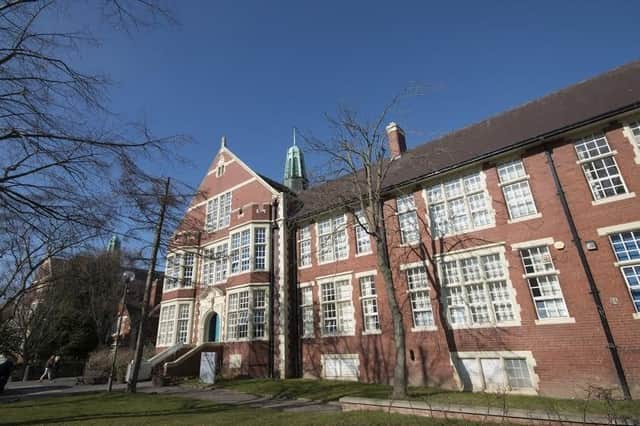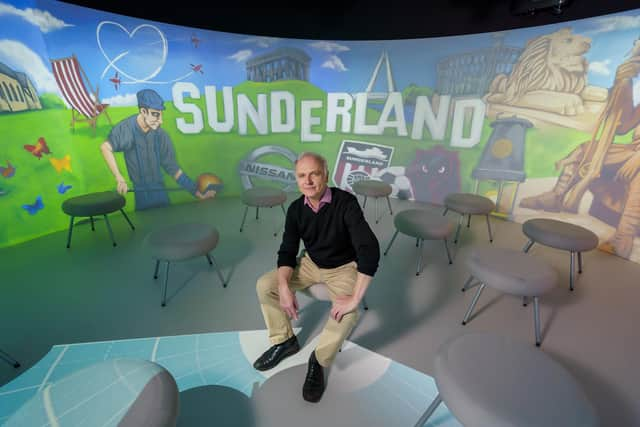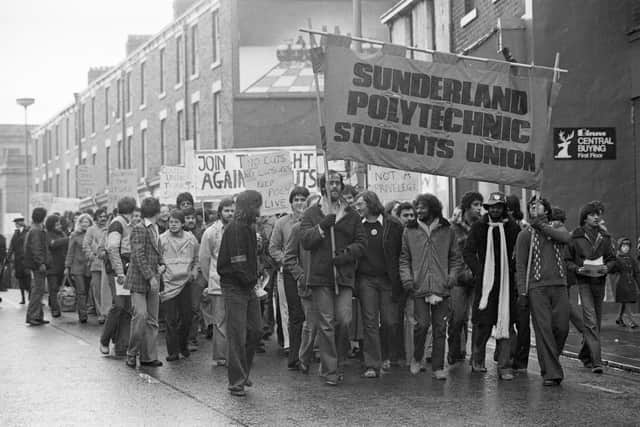Celebrating 60 years of further education in Wearside - looking back at the benefits Sunderland College has brought the city


Here Rob Lawson, former Chair of Sunderland College, looks at the history of FE on Wearside.
Sunderland has been celebrating six decades of further education (FE).
Advertisement
Hide AdAdvertisement
Hide AdFE first arrived on Wearside in September 1962 after what was then Sunderland Corporation borrowed £266,000 from the Government to transform the old Monkwearmouth Grammar School in Swan Street into a further education college.


Monkwearmouth College of Further Education was organised into two departments – the department of commerce and administration that taught secretarial and business studies and general studies, and the department of science that taught GCE science and other qualifications in chemistry and applied maths.
The college’s first Principal was Dr Jan Stevenson, who’d been a young lawyer in Ostrava, Czechoslovakia when the German army invaded his country. Jan fled to England and worked as a farm labourer, a foreman in a flour mill and an examiner of letters in the wartime postal censorship department in Liverpool.
He then entered teaching, while adding further qualifications to the law degree and doctorate he had completed in his native country. He had taught at several grammar and technical schools before accepting the Monkwearmouth College role.
Advertisement
Hide AdAdvertisement
Hide AdGerard Elder, Learning Innovation Manager at Sunderland College, has worked in the sector for more than 30 years and spent many years at Monkwearmouth College before it merged with Wearside College in 1996. Gerard is regarded as Sunderland College’s unofficial historian.


“Monkwearmouth College was launched in a different era – 60 years ago The Beatles were just finding their feet, while in Sunderland shipyards and mines still employed very large numbers of working men. Sunderland was a different place then and one of the new college’s top priorities was to train a workforce for the thriving shipyards and heavy industries.
“Dr Stevenson was soon joined by Freda Storrier who came to the college as a head of department but was to become vice principal – the first female VP of a further education college in the country. She was a very popular and influential figure in the College’s early years and worked tirelessly to ensure the highest educational standards.”
Numbers of students – full-time, day release and evening – rose steadily as the college expanded its range of courses and its estate.
Advertisement
Hide AdAdvertisement
Hide AdIn 1972 Sunderland gained a second further education college when Wearside College of Further Education opened its doors on Sea View Road West. The new building was opened by the then Secretary of State for Education, Margaret Thatcher.


The curriculums of both college looked similar, but Wearside College was the first to offer a hint of the future when it added computer science to its roster of studies and qualifications.
As the Wear shipyards and mines closed during the 1970s and 1980s and the economic base of the region evolved, both colleges continued to revise the programmes of study they were offering, as the skills needs of the city were shifting dramatically.
“It was no good training a workforce for the yards and the pits when they were closing so quickly. That same period saw social change in which it became more commonplace for women to study a much wider range of qualifications than just secretarial or domestic science courses,” explained Gerard.
Advertisement
Hide AdAdvertisement
Hide AdIn 1987 Monkwearmouth College opened a new centre in Southwick in the former St Thomas Aquinas School. This site would be used for further education for the next 29 years, being referred to as the Redcar Road Centre, then the Hylton Centre and finally, as the Hylton Campus. It closed its doors for the last time in June 2016.


“I worked there for many years as the centre librarian and I have to say it was a very popular centre with everyone - students and staff – and there was a real sense of pride there, both in our academic success and in the support we gave all our students,” said Gerard.
The year 1989 brought two major changes to the city’s FE landscape. Post-16 education was reorganised into a tertiary system, with both Monkwearmouth and Wearside colleges becoming tertiary colleges. In the same year, Wearside College acquired a new site, the former Bede Grammar School on Durham Road. Monkwearmouth College also acquired a new site that became the Shiney Row Centre on Success Road, Houghton-le-Spring.
In 1992, the year Sunderland became a city, Monkwearmouth College started working with the University of Sunderland on the delivery of a wide range of higher education programmes.
Advertisement
Hide AdAdvertisement
Hide AdThe following year, 1993, colleges around the country went through the process of ‘incorporation’ by which they left the control of local government and became independent corporations, each led by a governing body. Funding came from central government and FE colleges became corporate businesses.
Not long later informal merger talks began between the two colleges. In March 1995, the boards at both institutions approved a merger plan and began public consultation.
In January 1996, the merger was officially confirmed and the City of Sunderland College was incorporated.


Ian Todd was the new College’s first principal. “I remember Ian joining us that first year. He was a great appointment and was principal for ten years, overseeing many major developments including the £1.5m redevelopment of the Redcar Road Centre.
Advertisement
Hide AdAdvertisement
Hide Ad“The merger was relatively smooth, although one of the challenges was combining all our procedures and systems together into one. Curriculum-wise, it was relatively straightforward and all the staff worked really hard to unify us for the benefit of the city,” said Gerard.
As well as new developments, there were closures - the Swan Street Centre closed in 1998 and the Tunstall Centre on Sea View Road West closed at around the same time, exactly 30 years after it opened.
The next big change in FE provision in the city came in 2002 when, following a 14-to-19 Area Inspection, the college created a confederation of sixth form centres to which most non-denominational 11 to 16 pupils in the city were to attend.
Bede Sixth Form Academy opened in 2004; St Peter’s Sixth Form College was founded in 2005 but didn’t move into its new £6.5m riverside building until 2008; and construction of Usworth Sixth Form Centre, eventually rebranded as Sunderland College’s Washington Campus, started in 2005.
Advertisement
Hide AdAdvertisement
Hide AdAfter a successful decade at the helm, Principal Ian Todd retired the following year and was replaced by Angela O’Donoghue.
In 2008 City of Sunderland College’s new St Peter’s Sixth Form College, was officially unveiled by the University of Sunderland’s Chancellor, former Olympic Athlete Steve Cram MBE.
More than 500 students moved in to the building, which was sold to the university 12 years later.
In 2011 City of Sunderland College altered its name to the shorter Sunderland College and in that same year the new Football Development Centre was opened at the Bede site.
Advertisement
Hide AdAdvertisement
Hide AdIn 2013, the College welcomed another new principal as Anne Isherwood replaced Angela O’Donoghue, who had taken up a new challenge at South Essex College of Further and Higher Education.
Anne’s first year in charge was a busy one. In 2014 she oversaw the decision to close the Shiney Row Campus, major refurbishments at Bede Learning Centre and the opening of two new purpose-built building on the Bede site – the Sports and Arts Academies.
The college board had been debating whether to rejuvenate the Hylton Road site, but instead opted to work with Sunderland City Council to create a new City Campus on Park Lane, right next to the council’s Civic Centre.
This state-of-the-art, £29m building was formally opened in September 2016, with new Principal Ellen Thinnesen, who had replaced Anne Isherwood at the beginning of the year, being handed the keys.
Advertisement
Hide AdAdvertisement
Hide Ad“We’ve always been fortunate to have outstanding leaders who’ve set the right tone and culture for our student and staff communities. With Ellen’s arrival, we saw this amplified and we’ve taken amazing strides forward, with our emphasis being very much on continually striving for academic excellence across our entire curriculum offer and actively fostering a positive culture of equality and inclusivity,” said Gerard.
Those strides included a merger with Hartlepool Sixth Form in 2017 and a further merger with Northumberland College in 2019, when the three colleges were incorporated into the new Education Partnership North East.
Ellen became Chief Executive of the college group, allowing a new Sunderland College Principal, Toni Rhodes, to be appointed in 2021.
Ellen said: “FE and Sunderland College have a long and proud history in Sunderland. We have educated and trained generations of Wearsiders, and although subjects taught have changed to align with the needs of the local economy and businesses, our huge ambitions for our students and Sunderland as a city remain undimmed.
Advertisement
Hide AdAdvertisement
Hide Ad“We are passionate about positively contributing to the social, economic and educational outcomes of the city – and through the wider EPNE group – our region.
“None of this would be possible without the talent and dedication of our hardworking staff – across EPNE our people make a positive difference in the lives of our community of 21,500 students.”
As well as the EPNE mergers, major developments at Sunderland College since Ellen’s appointment have included a multi-million pound DfE T level Capital Fund investment in Bede and City campuses, which includes:
Bede Campus – an Innovation Space which includes a 360-degree, immersive space which allows students to train and study in a variety of virtual reality environments.
Advertisement
Hide AdAdvertisement
Hide AdCity Campus – another 360-degree immersive space, collaborative spaces, a Building Information Modelling suite and state-of-the-art engineering and manufacturing workshops.
The college has also worked closely with Sunderland City Council and other partners to develop new campus and teaching space across Sunderland. These include:
The Housing Innovation and Construction Skills Academy (HICSA), a visionary, collaborative project working with Sunderland City Council and the Ministry of Building Innovation and Education (MOBIE). HICSA, under construction on the city’s Riverside, will be one of the region’s leading facilities that will educate, train and upskill local people in modern construction methods;
New employability training facilities launched alongside the Department for Work & Pensions and Gentoo in Sunderland City Hall.
College sites
Bede Campus
Advertisement
Hide AdAdvertisement
Hide AdBede Campus is the specialist centre for health and care, digital, A-Levels, sports and visual and performing arts courses. It is also home to a dedicated sixth form for academic study, science labs, health simulation ward, industry standard digital suite, state-of-the art Sports Academy and £11 million Arts Academy. The campus also includes a newly-furnished, specialist centre for students, special education needs and disabilities. The campus also includes the Goals Soccer Centre with all-weather 3G 5-a-side pitches.
City Campus
City Campus has an extensive range of industry-standard equipment for vocational study from specialist construction and engineering workshops to a simulated aircraft for Travel and Tourism students. In addition there is commercial hair, barbering and beauty salons, a travel agency, restaurant and kitchens.
Washington Campus
Built on the site of the former Usworth School, Washington Campus is home to Sunderland College’s higher education provision, providing a range of courses from HNCs and HNDs to honours degrees and professional qualifications.
The 14,300 students and what they study
Sunderland College is one of the largest providers of post-16 further and higher education in the North East with approximately 14,300 students. The college also has one of the widest range of courses in the region including technical, apprenticeship, A-Level and T Levels – and also offers a range of university degrees.
Advertisement
Hide AdAdvertisement
Hide AdThe college is rated 'Good' by Ofsted, with Personal Development of students, graded ‘Outstanding’ (2022) and its students consistently gain high achievement rates, well above the national average.
Awards include STEM Assured Accreditation (UK STEM Foundation 2022), National Beacon Finalist in Widening Participation (AoC 2022), BTEC College of the Year and a Silver Pearson Teaching Excellence Award for Team of the Year (2019).
The college has excellent links with more than 500 employers and achieved National Beacon Award status for its innovative engagement with external stakeholders and industry.